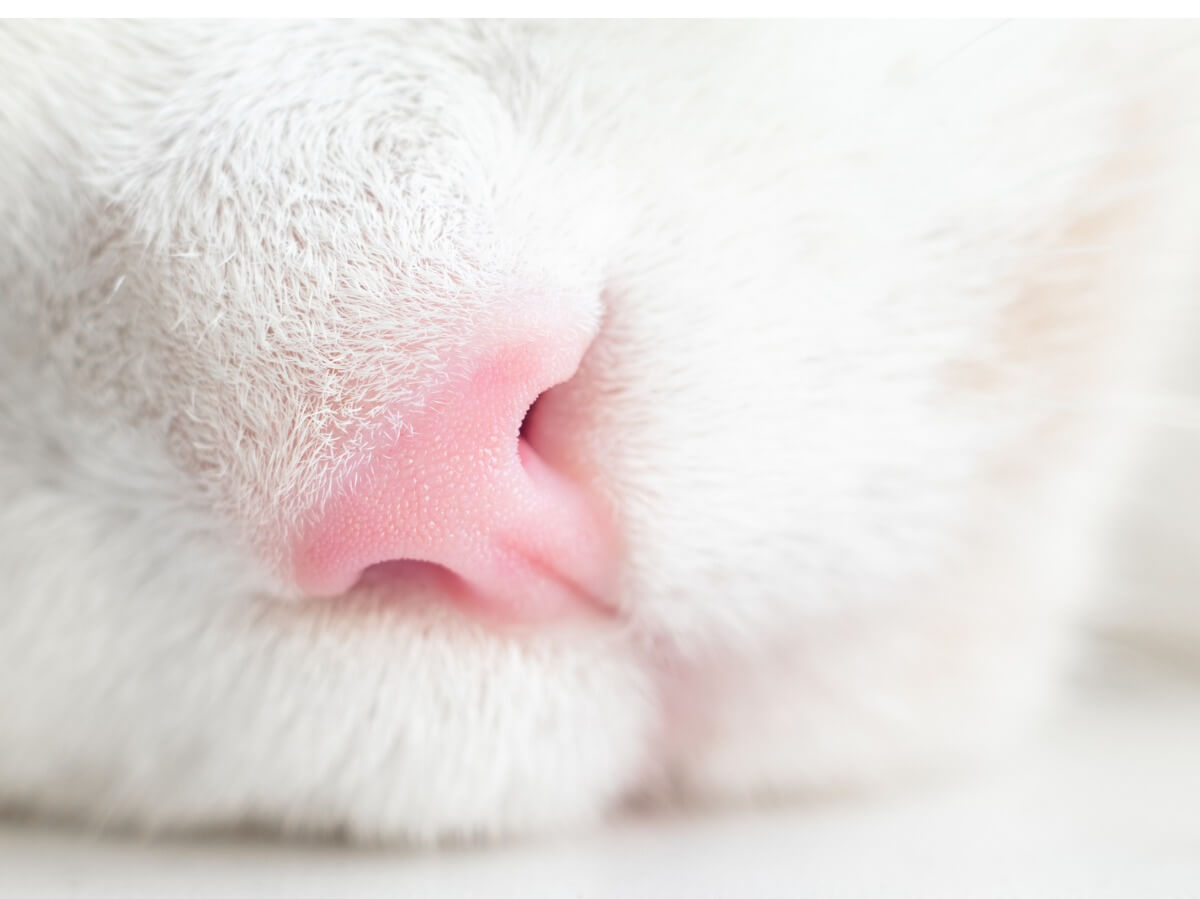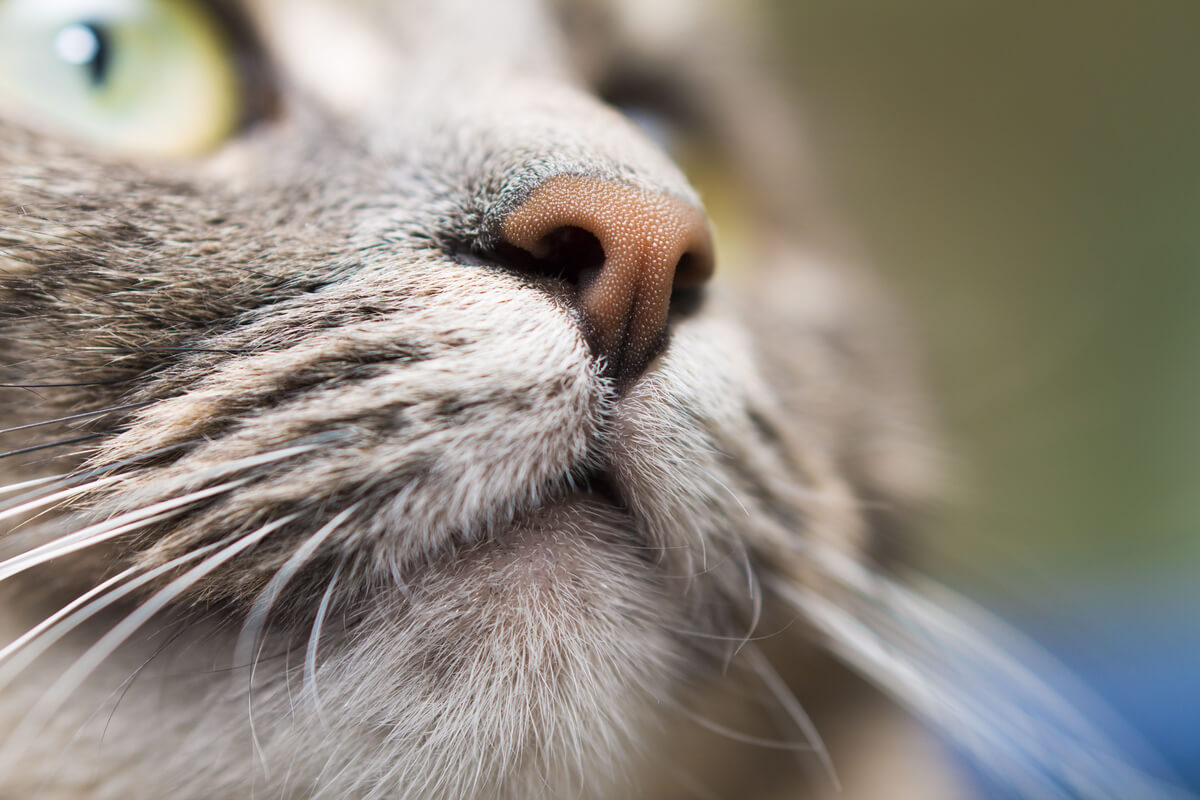Why Does My Cat Have a White Nose?


Written and verified by the biologist Samuel Sanchez
When we talk about smell, we automatically think of the extraordinary ability of canids to recognize scents. However, the olfactory apparatus of cats isn’t far behind. They have more than 200 million sensitive endings in their noses, and thanks to them, they smell 14 times better than us. Still, a white nose in cats can be a sign that something is wrong.
In most cases, the change in tone in the cat’s nose shouldn’t be a cause for concern. In any case, there are some pathological processes that can occur with this symptom. If you want to know more about the subject, keep reading.
Cats’ noses
At a morphological level, a cat’s nose is made up of the nasal plane, a septum and the pits, through which air and aromas enter. At the end of the fossae are the choanae, two openings in the back of the nasal cavity that communicate the exterior with the throat, marking the beginning of the nasopharynx. As we have said, felids have more than 200 million olfactory receptors in the area.
As indicated by professional veterinary sources, pathologies of the nasal passages are the most common conditions in dogs and cats, especially in their chronic variants. There are many diseases that can affect this area which is so important for breathing and smell. Cancer, viral infections, fungal attacks, and bacterial invasions are just some of them.
Allergies also manifest at a nasal level and are a common problem in cats.

Is it common for my cat’s nose to change color?
It’s normal for a cat’s nose to change color, but this variation in hue is temporary. In times of stress, when the heart rate and blood flow increase, it’s normal for this structure to change from a pale pink color to a more marked reddish color. This indicates that the animal’s body is alert and ready to respond.
It’s also normal for some felids to have lentigo in their noses – small dark and innocuous spots that appear due to the accumulation of melanocytes. If the cat has had them since childhood, there’s nothing to worry about. In any case, if reddish spots appear spontaneously on the nose, if it swells or anything else unusual, then it’s time to go to the vet.
Why does my cat have a white nose?
As we’ve said, it’s not a problem if the cat’s nose temporarily turns a little redder or paler than normal. However, if the cat’s nose is white and this is accompanied by other symptoms, it’s most likely that it’s suffering from an underlying pathology. Here are some of them.
Anemia
Anemia, in cats or any other vertebrate, is the lack of circulating red blood cells in the blood. As indicated by the International Cat Care portal, when an animal becomes anemic, the blood isn’t able to carry enough oxygen and some tissues are compromised. In the long term, it’s a very debilitating condition.
The nose is an excellent indicator of feline anemia, because being a highly vascular tissue, it’s one of the first to appear pale due to a lack of erythrocytes. Along with this sign, general weakness, pale gums, and a tongue that’s much less red than normal usually appear. Chronic diseases and nutritional deficiencies are the main reasons for sustained anemia.
Internal bleeding
Hemorrhages are the loss of blood in some part of the animal’s body. As the body is actively and constantly losing red blood cells, the more visible vascularized tissues will appear paler. In addition to a white nose in cats, bloody vomiting, weight loss, shortness of breath, and other serious signs are conceived in these cases.
Drug interactions and organ problems
If the cat’s nose is pale and also has a bluish tone, it’s possible that the cat may be suffering from hypoxia – a lack of oxygen in the blood. This doesn’t have to be linked to anemia, as, for example, it can arise from a problem in the lung, or from a bad reaction to a drug – such as paracetamol, which should never be used in cats.
The opposite case: a nose that’s redder than normal
The fact that the cat begins to show a redder nose over time can be a symptom of hypertension. As studies indicate, this condition is more common in older felines and those with kidney problems. In any case, this clinical sign by itself doesn’t show a clear systemic problem in the animal.

A white nose in cats isn’t usually a pathological sign
A white nose in domestic cats doesn’t have to be a warning sign of an illness. There’s a lot of morphological variability between the different breeds of cats and each cat has its own facial features – just like humans. In any case, the problem lies in the sudden change from a normal tone to a different one.
Above all, pay attention to the signs that accompany the whitening of the nasal tissue. If your cat is listless, stops eating, loses weight, or vomits blood, it most likely has a serious medical problem. In that case, you should go urgently to the vet with them,
When we talk about smell, we automatically think of the extraordinary ability of canids to recognize scents. However, the olfactory apparatus of cats isn’t far behind. They have more than 200 million sensitive endings in their noses, and thanks to them, they smell 14 times better than us. Still, a white nose in cats can be a sign that something is wrong.
In most cases, the change in tone in the cat’s nose shouldn’t be a cause for concern. In any case, there are some pathological processes that can occur with this symptom. If you want to know more about the subject, keep reading.
Cats’ noses
At a morphological level, a cat’s nose is made up of the nasal plane, a septum and the pits, through which air and aromas enter. At the end of the fossae are the choanae, two openings in the back of the nasal cavity that communicate the exterior with the throat, marking the beginning of the nasopharynx. As we have said, felids have more than 200 million olfactory receptors in the area.
As indicated by professional veterinary sources, pathologies of the nasal passages are the most common conditions in dogs and cats, especially in their chronic variants. There are many diseases that can affect this area which is so important for breathing and smell. Cancer, viral infections, fungal attacks, and bacterial invasions are just some of them.
Allergies also manifest at a nasal level and are a common problem in cats.

Is it common for my cat’s nose to change color?
It’s normal for a cat’s nose to change color, but this variation in hue is temporary. In times of stress, when the heart rate and blood flow increase, it’s normal for this structure to change from a pale pink color to a more marked reddish color. This indicates that the animal’s body is alert and ready to respond.
It’s also normal for some felids to have lentigo in their noses – small dark and innocuous spots that appear due to the accumulation of melanocytes. If the cat has had them since childhood, there’s nothing to worry about. In any case, if reddish spots appear spontaneously on the nose, if it swells or anything else unusual, then it’s time to go to the vet.
Why does my cat have a white nose?
As we’ve said, it’s not a problem if the cat’s nose temporarily turns a little redder or paler than normal. However, if the cat’s nose is white and this is accompanied by other symptoms, it’s most likely that it’s suffering from an underlying pathology. Here are some of them.
Anemia
Anemia, in cats or any other vertebrate, is the lack of circulating red blood cells in the blood. As indicated by the International Cat Care portal, when an animal becomes anemic, the blood isn’t able to carry enough oxygen and some tissues are compromised. In the long term, it’s a very debilitating condition.
The nose is an excellent indicator of feline anemia, because being a highly vascular tissue, it’s one of the first to appear pale due to a lack of erythrocytes. Along with this sign, general weakness, pale gums, and a tongue that’s much less red than normal usually appear. Chronic diseases and nutritional deficiencies are the main reasons for sustained anemia.
Internal bleeding
Hemorrhages are the loss of blood in some part of the animal’s body. As the body is actively and constantly losing red blood cells, the more visible vascularized tissues will appear paler. In addition to a white nose in cats, bloody vomiting, weight loss, shortness of breath, and other serious signs are conceived in these cases.
Drug interactions and organ problems
If the cat’s nose is pale and also has a bluish tone, it’s possible that the cat may be suffering from hypoxia – a lack of oxygen in the blood. This doesn’t have to be linked to anemia, as, for example, it can arise from a problem in the lung, or from a bad reaction to a drug – such as paracetamol, which should never be used in cats.
The opposite case: a nose that’s redder than normal
The fact that the cat begins to show a redder nose over time can be a symptom of hypertension. As studies indicate, this condition is more common in older felines and those with kidney problems. In any case, this clinical sign by itself doesn’t show a clear systemic problem in the animal.

A white nose in cats isn’t usually a pathological sign
A white nose in domestic cats doesn’t have to be a warning sign of an illness. There’s a lot of morphological variability between the different breeds of cats and each cat has its own facial features – just like humans. In any case, the problem lies in the sudden change from a normal tone to a different one.
Above all, pay attention to the signs that accompany the whitening of the nasal tissue. If your cat is listless, stops eating, loses weight, or vomits blood, it most likely has a serious medical problem. In that case, you should go urgently to the vet with them,
All cited sources were thoroughly reviewed by our team to ensure their quality, reliability, currency, and validity. The bibliography of this article was considered reliable and of academic or scientific accuracy.
- Anemia in cats, International Cat Care. Recogido a 11 de junio en https://icatcare.org/advice/anaemia-in-cats/
- Bodey, A. R., & Sansom, J. (1998). Epidemiological study of blood pressure in domestic cats. Journal of Small Animal Practice, 39(12), 567-573.
- Chen, Y. C., Hidayati, S. C., Cheng, W. H., Hu, M. C., & Hua, K. L. (2016, January). Locality constrained sparse representation for cat recognition. In International Conference on Multimedia Modeling (pp. 140-151). Springer, Cham.
- Wray, J. D., Sparkes, A. H., & Johnson, E. M. (2008). Infection of the subcutis of the nose in a cat caused by Mucor species: successful treatment using posaconazole. Journal of feline medicine and surgery, 10(5), 523-527.
- Mackey, L., Jarrett, W., Jarrett, O., & Laird, H. (1975). Anemia associated with feline leukemia virus infection in cats. Journal of the National Cancer Institute, 54(1), 209-217.
This text is provided for informational purposes only and does not replace consultation with a professional. If in doubt, consult your specialist.








